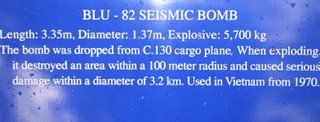The Remnants of War

 War. It has plagued man as long as man has existed, whether in hand to hand combat for the "rights" to a cave woman or the seemingly polite and formal British firing lines of the American Revolution or an aerial bombardment from 40,000 miles above the ground. Despite the fact that humans have the unique ability to foresee the outcome, each day around the globe, at least a hundred wars continue. For me, the past few weeks has been an unexpected up close and personal view of war.
War. It has plagued man as long as man has existed, whether in hand to hand combat for the "rights" to a cave woman or the seemingly polite and formal British firing lines of the American Revolution or an aerial bombardment from 40,000 miles above the ground. Despite the fact that humans have the unique ability to foresee the outcome, each day around the globe, at least a hundred wars continue. For me, the past few weeks has been an unexpected up close and personal view of war. Fortunate not to be drafted into service and even more fortunate to visit Vietnam thirty years after the war, my entire understanding of war was shaped by books, photos and the Discovery Channel, KQED and National Geographic. Yesterday, I had the unexpected and bone chilling experience to spend several hours at the War Remnants Museum in Ho Chi Minh City to add to my education. Disappointed from a failed visit to the Reunification Palace, the former "White House" for the South Vietnamese government, which remains largely untouched from the day it was abandoned in 1975, I went to my back-up plan, the War Museum. (Note: The Reunification Palace is scheduled to reopen in June 2006 after renovation.)
 ("Reunification Palace")
("Reunification Palace")Expecting a propaganda fest at the War Museum (formally known as the Museum of Chinese and American War Crimes), I anticipated breezing through the museum in thirty minutes or less. Already, I had visited the Vinh Moc tunnels, the Citadel in Hue, Khe San and many other sights of military significance. As the moto driver pulled up to the front gate, I could see the familiar US war tanks and planes parked in the front. I paid my 15,000 Dong ($1) admission fee and blazed in, ready to make a sweep in record time.

A spin through a few tanks and a Howitzer artillery gun, I moved inside to a thick wave of heat where a hundred plus on-lookers gazed at the walls in complete silence. Any description I attempt here is no substitute for an actual visit, putting faces to some of the more than 58,000 names of US troops killed or missing in action at the Vietnam War Memorial in Washington DC. In three rooms, there were mostly black and white photographs on every wall, some detailing the French conflict, but most highlighting the American War.
The most touching part of the memorial had never occurred to me before yesterday. One large room was dedicated to the journalists who covered the war, and in the process lost their lives. Fifty-four in all, pictures of the photographers killed in the field hung next to their "last photograph" plucked from their camera after their demise in a helicopter crash, or when their plane was shot down leaving Khe San, or after grabbing a gun and leading trapped troops out of harm in the thick of the jungle. The stories were incredible, exemplifying true bravery, conviction and mission. All of them were driven to report on the actual events so that the rest of the world could safely see the fear, ugliness and horrors of war.
It is their front line images of pained faces, mangled bodies and decimated landscapes that serve as grotesquely vigilant reminders that the battleground should be avoided where diplomacy and compromise still have a seat at the table. Thirty one years since the war concluded, the Vietnamese still live with geographic (dioxins in the soil from Agent Orange and unexploded mines and ordinance still embedded in the ground) and human scars as do many American veterans. There are lessons to be learned from the war, many of which were taught to me in college, but despite the lessons and losses, war continues like a bad roller coaster ride where no one can get off. Perhaps it is driven by DNA or superego or a bad childhood, whatever it is, there are few signs that man is actually learing from history, rather just repeating it.
The Vietnamese government still considers the "American War" as its greatest achievement since the Communist Party was founded by Ho Chi Minh during the Cold War era. Pictures of Marx, Stalin, Lenin and Ho Chi Minh hang in shops and on billboards throughout the country. There is a great deal of pride associated with the defeat of America, the Superpower. Diplomatic relations between the US and Vietnam resumed in 1993, President Clinton visited in 2000 and today Vietnam hopes to become a member of the World Trade Organization in 2006 The scars are slowly healing on this wound, but unfortunately it seems that the lessons too are fading with time.
 (Saigon by Day)
(Saigon by Day)
(Saigon by Night)


<< Home